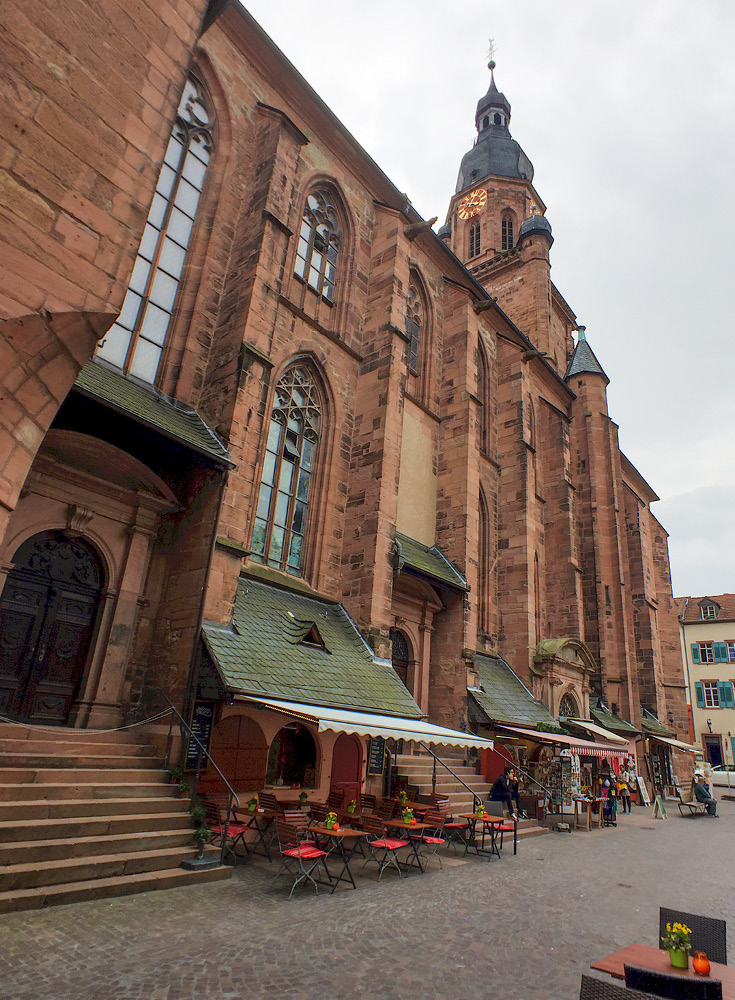Disclosure: Please note that some links are affiliate links, and at no additional cost to you, we earn a commission if you make a purchase.
If you would like to support this website in some way, using these links will help do exactly that.
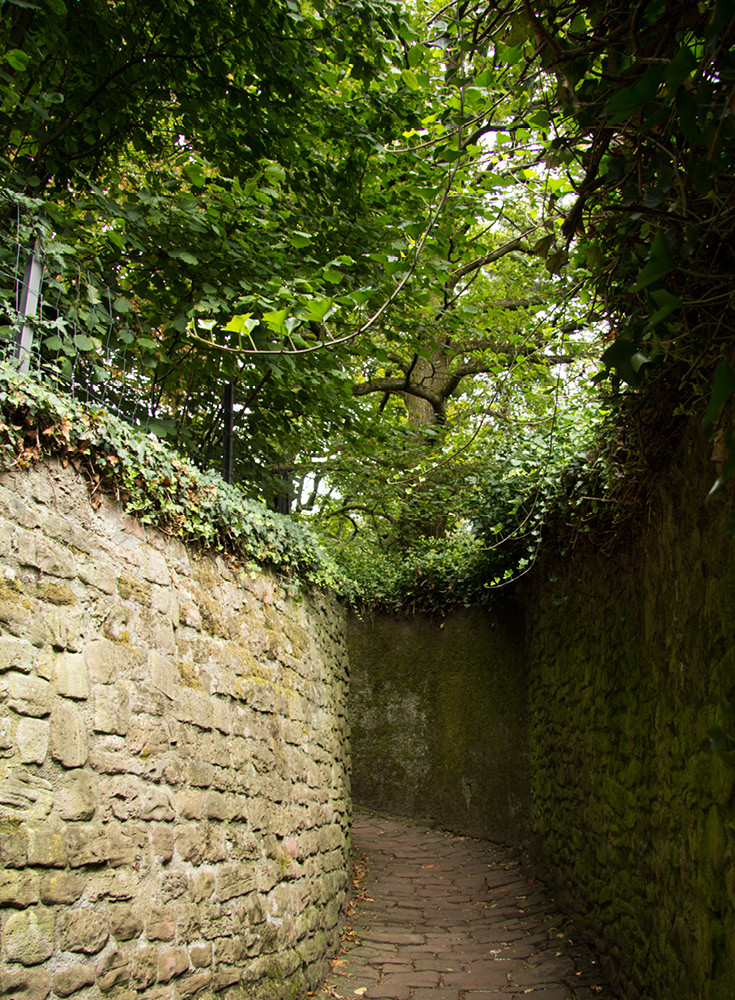
My legs are probably going to be a bit sore, I think, as I gasp for air. I let my fingers dust the stone wall beside me, mindful of the poison ivy and some thorny vines, with the sneaking suspicion I may just collapse at any moment. Every traveler that passes going back down briefly makes eye contact with a knowing, encouraging glance that seems to say, it's worth it, keep going!
Sebastian, his Dad, and I are tempted to stop at the first level lookout area that has shade and benches, but its already full.
No, let's go higher.
So we go higher. The second level lookout area has a view that is blocked by a tree, where no one sits.
No, let's go higher still.
We reach a somewhat small incline of about 15 degrees with a small, sunny meadow in front with just the view of the city we're looking for; the castle, churches, bridge, all framed by trees. We can step up on a ledge to see even better.
With plans on climbing the tower of the Heiliggeistkirche Church later, I need to save some energy.
 Going down is just as tricky because the cobblestone paths are now going against us and stick up waiting to catch toes. I keep lagging behind, stopping to take pictures as an excuse for catching my breath. I'm going to be very, very sore tomorrow, but for the best panoramic views of Heidelberg, it pays to climb up the Schlangenweg, snake path. Named appropriately due to its winding path, before you get to see the stunning views, you will have to walk UP about 1600 feet. It is a steep climb and not recommended when the path is slippery. Schlangenweg trail connects downtown Heidelberg starting at the Old Bridge up to the Philosophenweg, the philosopher's path.
Going down is just as tricky because the cobblestone paths are now going against us and stick up waiting to catch toes. I keep lagging behind, stopping to take pictures as an excuse for catching my breath. I'm going to be very, very sore tomorrow, but for the best panoramic views of Heidelberg, it pays to climb up the Schlangenweg, snake path. Named appropriately due to its winding path, before you get to see the stunning views, you will have to walk UP about 1600 feet. It is a steep climb and not recommended when the path is slippery. Schlangenweg trail connects downtown Heidelberg starting at the Old Bridge up to the Philosophenweg, the philosopher's path.

Take a left at the end of the Schlangenweg to continue on the Philosophenweg path for about 2.5 miles. It will end in the Neuenheim city part of Heidelberg, more of a residential area. Head south to the Theodor-Heuss-Bruecke, which is the closest bridge to get you back to downtown Heidelberg. If you do not want to walk the Philosophenweg, you can head down the Schlangenweg back to where you started.
Follow Along
If you enjoyed this article, or these topics sound interesting to you, you'll love our weekly newsletter. You'll receive the newest posts each week and exclusive access to free planning resources like ‘Packing List & Tips for 2 Weeks in Germany’ and ‘Everything You Need to Rent a Car in Germany’.
Thank you for reading!

One of my favorite city souvenirs is local sweets, and Heidelberg has a great piece of edible history that you can take home with you and share. It is called Studentenkuss, which translates to student kiss. It is made with nougat on a waffle bottom, covered in dark chocolate. Let’s dive into the history of this product for a moment and imagine Heidelberg in 1863.
During the nineteenth century, young women were often only allowed in public, when they were accompanied by aunts or older sisters. Contact or meetings with men were therefore only possible under the supervision of an extra set of watchful eyes. The Café Knösel in Heidelberg became a popular meeting point for young ladies of the local girls' boarding school, but also for students of the Ruprecht-Karls-University.

Café operator and confectioner Fridolin Knösel invented the student kiss in 1863, a delightful, sweet treat. The chief attraction, besides the great taste, was the packaging. The student kiss chocolate came in a small box, often accompanied by a handwritten message which could not be seen by the chaperones of the young women. This made it much easier for the young men to flirt and communicate with the adored girl. Even without a handwritten message, printed on each chocolate foil, is a student of a student union with student cap and a young woman right before they are about to kiss. If you receive a chocolate like this, you know that someone has feelings for you.
Much time has passed since 1863, but the students kiss chocolate still exists today as an amicable reminder of bygone, romantic times. The sweet idea of Fridolin Knösel developed into a small piece of Heidelberg's history and is still produced fresh several times per week. The original Café Knösel, where the Heidelberg student kiss was invented, was sold and does not belong to the Knösel family anymore. The student kisses, however, are still made and sold by the Knösel siblings, two houses away from Café Knösel.
Follow Along
If you enjoyed this article, or these topics sound interesting to you, you'll love our weekly newsletter. You'll receive the newest posts each week and exclusive access to free planning resources like ‘Packing List & Tips for 2 Weeks in Germany’ and ‘Everything You Need to Rent a Car in Germany’.
Thank you for reading!

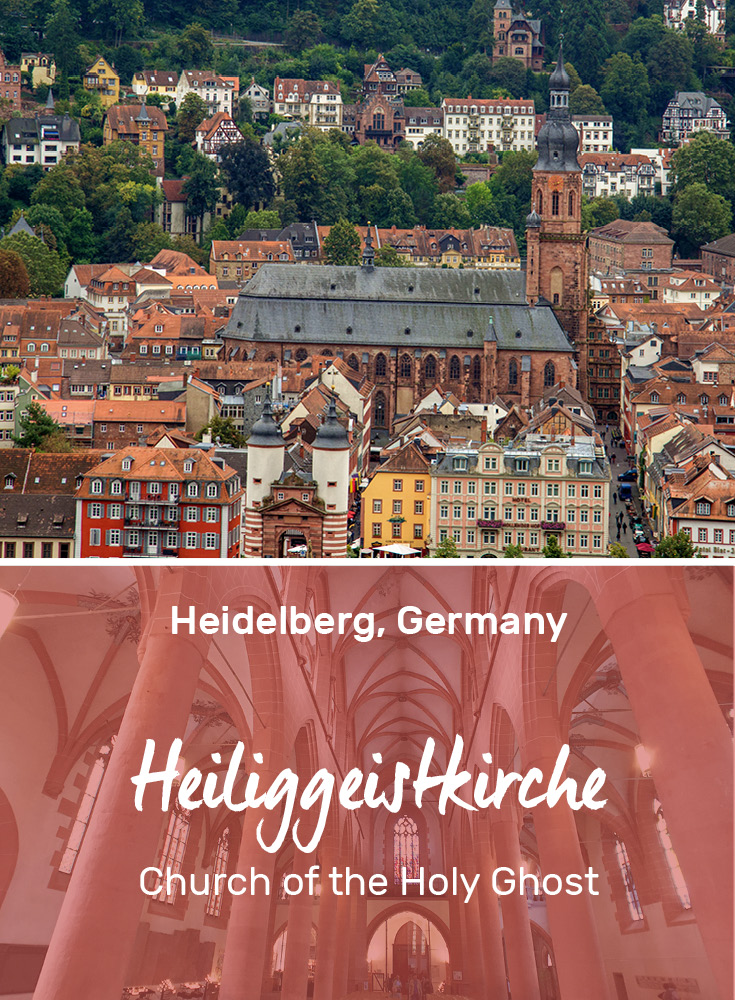
The Church of the Holy Ghost is the largest and most important church in Heidelberg. It is located on the market square in the middle of the town, where its tower dominates the cityscape. The gothic church was built from red sandstone between 1398 and 1515. Originally it was planned as a burial place for the Elector of the Palatinate and as a representative church for the region. Today, only the tomb of the builder of the church choir, Elector Ruprecht III, is still found in the church.
Protestant and/or Catholic Church?
The Church of the Holy Ghost is also known for its changing confessional history. From 1706 to 1936, more than 200 years, the church was divided into two parts by a wall. The nave was Protestant, the choir was Catholic. It was not until 1936 that an agreement was reached with the Catholic church and the removal of the wall was celebrated with a service in the church on June 24, 1936. At last the original spatial impression of the church, as the builders had designed it and wished for, was restored. A memorial plaque at the steps to the choir on the right side recalls this event and give you a pretty good glimpse of where the wall would have been.
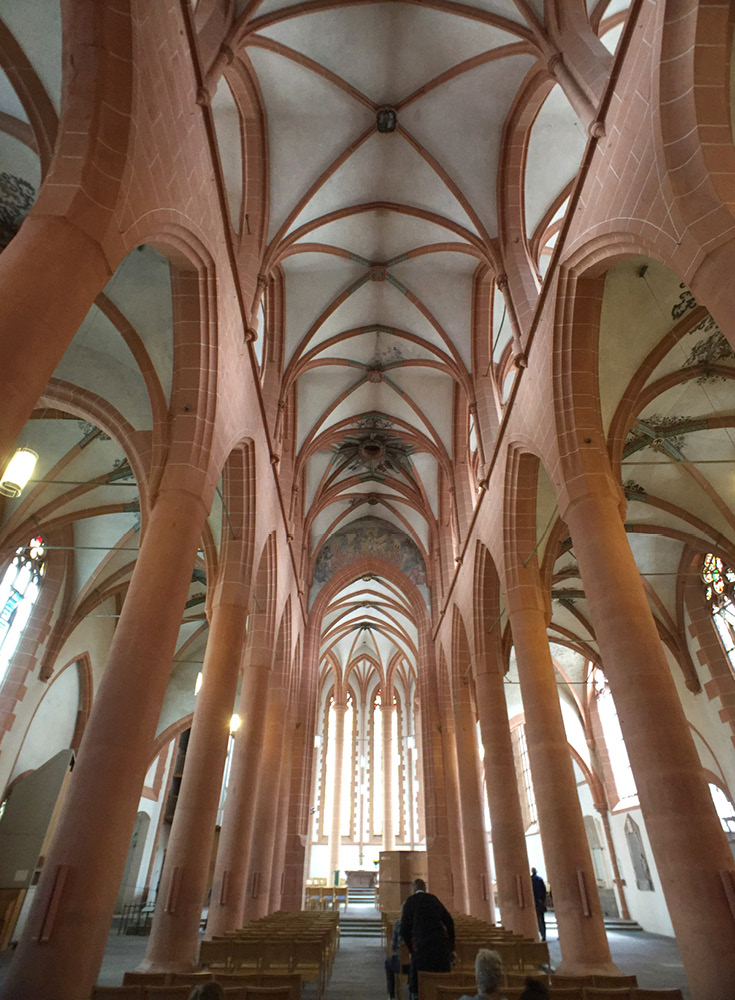
The Church of the Holy Ghost is considered a three-nave hall church and is oriented to the east. The entire church room is divided into two parts, the nave in the front, the choir in the rear. Between the nave and the choir is a triumphal arch. Look around and you will see that the church space looks rather simple, almost a bit empty. This was not always the case. Before the Reformation, the whole church was decorated with magnificent altars, sacred images, and organs. These objects were removed and destroyed during the Reformation period, which started in 1517.
Heidelberg Painter Harry MacLean
Let your view wander up to the arch of the nave and discover the picture on the ceiling called Engelskonzert, Concert of the Angels, from the 15th century. Eight angels with different musical instruments are shown. During a restoration in the 1950s, the Heidelberg painter Harry MacLean added a bassoon to an angel as a reminder of the present.
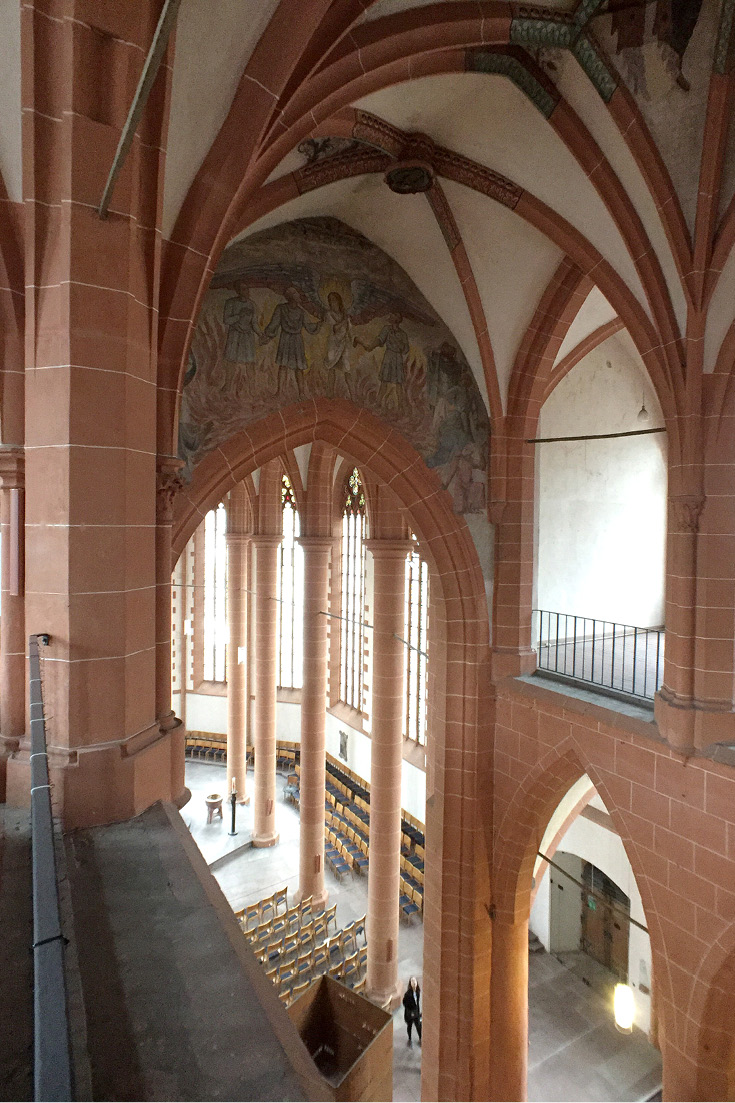
Walking towards the triumphal arch between the nave and the choir, you can spot another painting by Harry McLean from the 1950s. It is called Drei Männer im Feuerofen, Three men in the Fire Stove, and is a story from the Old Testament in the Bible. In the narrative found in Daniel’s book, chapter 3, a king throws the three men into a fire stove, but the fire does not even burn their clothes. The men are uninjured from the oven, forcing the king to believe that there is a God. Let your gaze wander along the high columns, looking towards the organ. Above the organ you will find several spiritual symbols, including a lamb, the hand of God the Father and the dove as a symbol of the Holy Spirit.
Tomb of Elector Ruprecht III
In the middle nave of the chorus, in addition to the closing stones with the Palatine Lion and the Bavarian rhombuses, the slightly larger one with the depiction of an eagle. This is one of the oldest depictions of the German Reichsadler. This final stone crowned in remembrance of the builder of the choir, Elector Ruprecht III. His tomb was originally directly underneath, at the place where the altar stands today. He died in the year of the completion of the new choir in 1410. You can find his tombstone on the northern side nave, directly adjacent to the choir. Engraved into the tombstone are the king with his wife, Elisabeth von Hohenzollern. At the king's feet is a lion, the symbol of the strength and the arms of the Kurpfalz region. At the foot of the queen you can see a dog, the sign of loyalty.
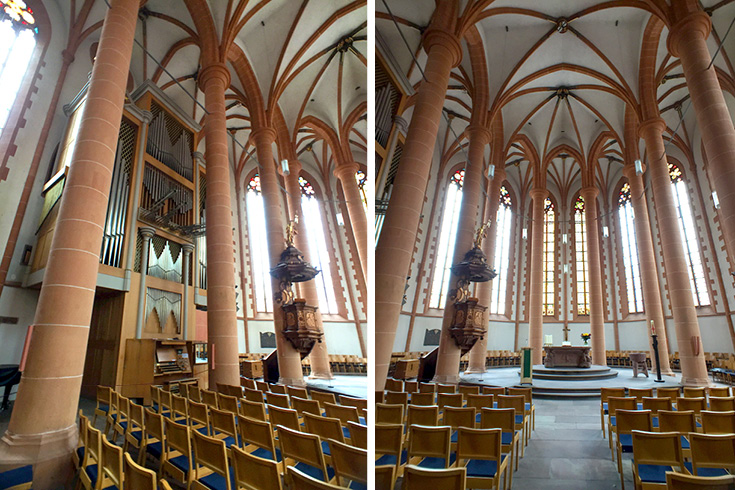
Church Organ
The organ in the church is not as old as you might think. It is called Steinmeyer/Lenter Organ and was the last organ built by the G. F. Steinmeyer & Co. company. The construction of this organ started in 1980 and completed in 1994 by Steinmeyer. It has 63 registers, about 5000 pipes and is the 13th organ to be installed in the Heiliggeistkirche. The intonation (pitch accuracy adjustment) was done by Gerhard Lenter in 1997, which led to a softer sound pattern. Music traditionally plays a special role in the Church of the Holy Ghost. The organ is played every week during the community church services as well as in festive services, and even for classical concerts. Check with the person at the entrance door for upcoming concerts if you want to hear the organ during your visit to Heidelberg.
Tower Tour
End your visit by climbing the 204 steps to the tower. From there you have a wonderful view of the castle, the river and, of course, the city itself. It is well worth the small fee of 2 Euros.
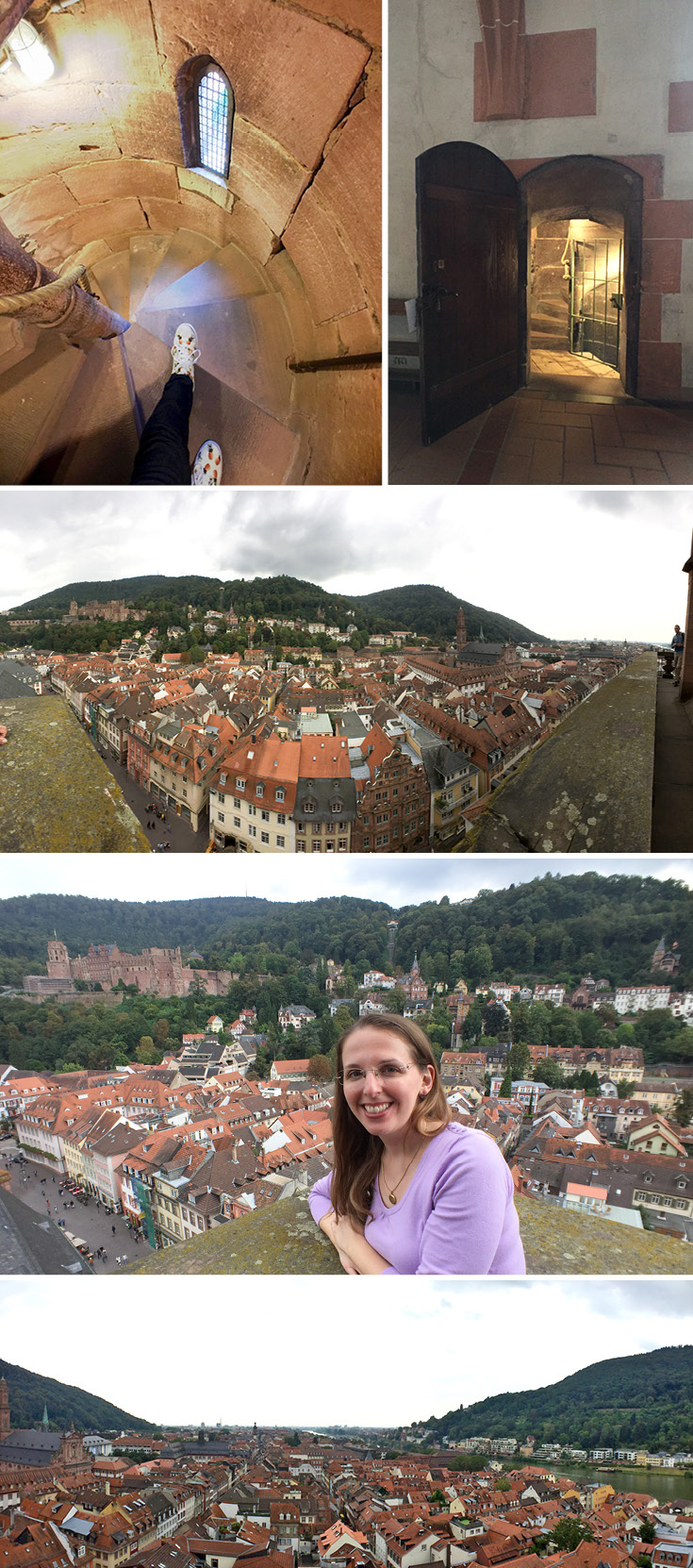
Follow Along
If you enjoyed this article, or these topics sound interesting to you, you'll love our weekly newsletter. You'll receive the newest posts each week and exclusive access to free planning resources like ‘Packing List & Tips for 2 Weeks in Germany’ and ‘Everything You Need to Rent a Car in Germany.
Thank you for reading!

